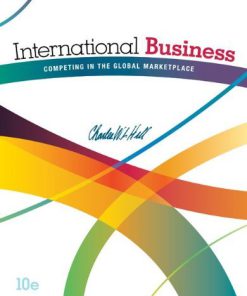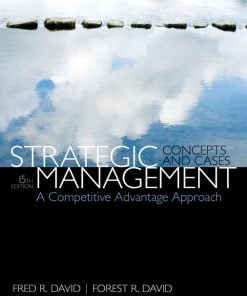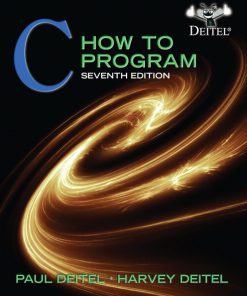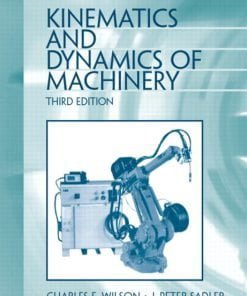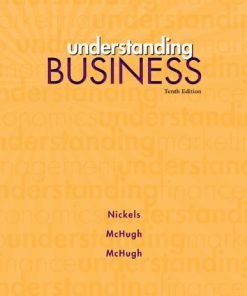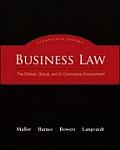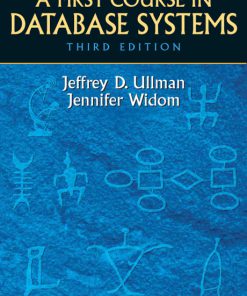Groundwater Hydrology Engineering Planning and Management 1st Ahmadi Solution Manual
$35.00 Original price was: $35.00.$26.50Current price is: $26.50.
Groundwater Hydrology Engineering Planning and Management 1st Ahmadi Solution Manual
Groundwater Hydrology Engineering Planning and Management 1st Ahmadi Solution Manual
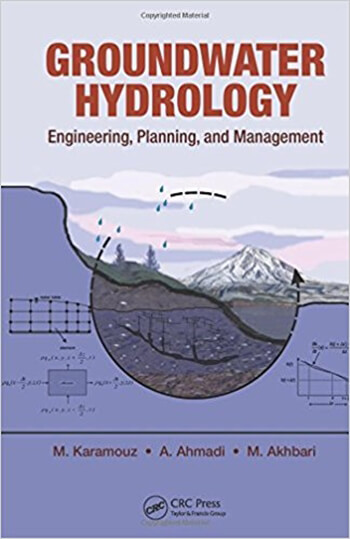
Product details:
- ISBN-10 : 0367211475
- ISBN-13 : 978-0367211479
- Author:
Increasing demand for water, higher standards of living, depletion of resources of acceptable quality, and excessive water pollution due to urban, agricultural, and industrial expansions have caused intense environmental, social, economic, and political predicaments. More frequent and severe floods and droughts have changed the resiliency and ability of water infrastructure systems to operate and provide services to the public. These concerns and issues have also changed the way we plan and manage our surface and groundwater resources. Groundwater Hydrology: Engineering, Planning, and Management, Second Edition presents a compilation of the state-of-the-art subjects and techniques in the education and practice of groundwater and describes them in a systematic and integrated fashion useful for undergraduate and graduate students and practitioners. This new edition features updated materials, computer codes, and case studies throughout.
Table contents:
Preface ………………………………………………………………………………………………………xxi
Acknowledgments ……………………………………………………………………………………..xxv
Authors …………………………………………………………………………………………………..xxvii
Chapter 1 Introduction ………………………………………………………………………………1
1.1 Introduction ………………………………………………………………………1
1.2 Water Availability ………………………………………………………………2
1.2.1 Groundwater Availability …………………………………………4
1.3 Groundwater Systems ………………………………………………………..5
1.4 Science and Engineering of Groundwater ……………………………..6
1.5 Planning and Management of Groundwater ………………………….8
1.5.1 Integrated Water Resources Management …………………10
1.5.2 Conflict Issues in Groundwater ……………………………….10
1.5.3 Economics of Water ………………………………………………11
1.5.4 Groundwater Sustainability …………………………………….13
1.5.5 Supply and Demand Side Management ……………………15
1.6 Tools and Techniques ……………………………………………………….17
1.7 People’s Perception: Public Awareness ……………………………….19
1.8 Groundwater Protection: Concerns and Acts ……………………….20
1.8.1 Clean Water Act…………………………………………………….21
1.8.2 Groundwater Protection …………………………………………21
1.8.3 USEPA Groundwater Rule ……………………………………..22
1.8.4 California’s Sustainable Groundwater
Management Act …………………………………………………..23
1.9 Overall Organization of This Book …………………………………….24
Problems …………………………………………………………………………………25
References ………………………………………………………………………………25
Chapter 2 Groundwater Properties …………………………………………………………….29
2.1 Introduction …………………………………………………………………….29
2.2 Vertical Distribution of Subsurface Water ……………………………31
2.3 Aquifers, Aquitards, and Aquicludes ………………………………….33
2.4 Types of Aquifers …………………………………………………………….33
2.4.1 Unconfined Aquifer ……………………………………………….33
2.4.2 Confined Aquifers …………………………………………………34
2.4.3 Aquitard (Leaky) Aquifer ……………………………………….34
2.5 Groundwater Balance ……………………………………………………….35
2.5.1 Water Balance in Confined Aquifers ………………………..36
2.5.2 Water Balance in Unconfined Aquifers …………………….37
2.5.3 Water Balance in Unsaturated Zone …………………………37
2.6 Compressibility and Effective Stress …………………………………38
2.6.1 Compressibility of Water …………………………………….38
2.6.2 Effective Stress ………………………………………………….38
2.6.3 Compressibility of a Porous Medium ……………………40
2.6.4 Effective Stress in the Unsaturated Zone ………………42
2.7 Aquifer Compressibility ………………………………………………….42
2.8 Aquifer Characteristics ……………………………………………………43
2.8.1 Porosity and Void Ratio ………………………………………44
2.8.2 Specific Yield in Unconfined Aquifers ………………….46
2.8.3 Specific Retention………………………………………………47
2.8.4 Storage Coefficient and Specific Storage ………………48
2.8.5 Safe Yield of Aquifers ………………………………………..52
2.9 Storage in the Unsaturated Zone ………………………………………52
2.10 Water-Level Fluctuations …………………………………………………55
2.11 Groundwater in Karst ……………………………………………………..55
2.11.1 Karst Aquifer …………………………………………………….55
2.11.2 Types of Karst……………………………………………………56
2.11.3 Fluctuation of Karst Aquifer ………………………………..56
2.11.4 Recharge of Karst Aquifer …………………………………..57
2.11.5 Groundwater Tracing in Karst ……………………………..58
2.11.6 Water Resources Problems in Karst ……………………..58
Problems …………………………………………………………………………………59
References ………………………………………………………………………………61
Chapter 3 Groundwater Hydrology ……………………………………………………………63
3.1 Introduction …………………………………………………………………..63
3.2 Groundwater Movement ………………………………………………….63
3.2.1 Darcy’s Law ………………………………………………………63
3.2.1.1 Validity of Darcy’s Law…………………………68
3.2.2 Hydraulic Head ………………………………………………….68
3.2.3 Hydraulic Conductivity ………………………………………69
3.2.3.1 Hydraulic Conductivity in Saturated
Media ………………………………………………….69
3.2.3.2 Hydraulic Conductivity in Unsaturated
Media ………………………………………………….70
3.2.3.3 Laboratory Measurement of Hydraulic
Conductivity ………………………………………..72
3.2.3.4 Field Measurement of Hydraulic
Conductivity ………………………………………..74
3.3 Homogeneous and Isotropic Systems ………………………………..75
3.3.1 Hydraulic Conductivity in Multilayer Structures ……76
3.4 Transmissivity ……………………………………………………………….80
3.5 Dupuit–Forchheimer Theory of Free-Surface Flow …………….81
3.6 Groundwater Flow in Unsaturated Zone ……………………………83
3.7 Flownets ………………………………………………………………………….88
3.7.1 Isotropic and Homogeneous Media ………………………..88
3.7.2 Heterogeneous Media …………………………………………..92
3.7.3 Anisotropic Media ……………………………………………….93
3.8 Statistical Methods in Groundwater Hydrology ……………………95
3.8.1 Normal Distribution ……………………………………………..95
3.8.2 Lognormal Distribution ………………………………………..97
3.8.3 t-Distribution ……………………………………………………….98
3.8.4 Chi-Square (χ2) Distribution ………………………………..100
3.8.5 Errors ……………………………………………………………….100
3.8.5.1 Sampling Error ……………………………………100
3.8.5.2 Standard Errors …………………………………..100
3.8.6 Estimating Quantiles (Percentiles) ……………………….101
3.8.7 Probability/Frequency/Recurrence Interval ……………102
3.9 Time Series Analysis ………………………………………………………103
3.9.1 Nonstationary Hydrologic Variables ……………………..103
3.9.2 Hydrologic Time Series Modeling ………………………..104
3.9.3 Data Preparation ………………………………………………..105
3.9.4 Parameter Estimation ………………………………………….108
3.9.4.1 Method of Moments ……………………………108
3.9.4.2 Method of L-Moments …………………………109
3.9.4.3 Method of Least Squares ……………………..110
3.9.4.4 Method of Maximum Likelihood ………….111
3.9.5 Goodness of Fit Tests ………………………………………….113
3.9.5.1 Chi-Square Goodness of Fit Test …………..113
3.9.5.2 Tests of Normality ………………………………115
3.9.6 Akaike’s Information Criterion …………………………….117
3.9.7 Autoregressive Modeling …………………………………….117
3.9.8 Moving Average Process ……………………………………..121
3.9.9 Autoregressive Moving Average Modeling ……………122
3.9.9.1 Generation and Forecasting Using
ARMA Models …………………………………..122
3.9.10 Autoregressive Integrated Moving Average
Modeling …………………………………………………………..123
3.9.10.1 Time Series Forecasting Using
ARIMA Models ………………………………….124
Problems ……………………………………………………………………………….130
Appendix ………………………………………………………………………………132
References …………………………………………………………………………….135
Chapter 4 Hydraulics of Groundwater ……………………………………………………..139
4.1 Introduction ………………………………………………………………….. 139
4.2 Continuity Equation ………………………………………………………..139
4.3 Equation of Motion in Groundwater …………………………………142
4.3.1 Groundwater Flow Equation ………………………………..144
4.4 Wells …………………………………………………………………………….153
4.4.1 Steady Flow into a Well ………………………………………..155
4.4.1.1 Confined Flow ………………………………………..155
4.4.1.2 Unconfined Flow …………………………………….158
4.4.2 Unsteady State in a Confined Aquifer …………………….161
4.4.2.1 Aquifer Test Application ………………………….165
4.4.2.2 Theis Method of Solution ………………………..166
4.4.2.3 Cooper–Jacob Method of Solution ……………168
4.4.2.4 Variable Pumping Test …………………………….172
4.4.3 Unsteady State for Unconfined Aquifer ………………….175
4.5 Multiple-well Systems …………………………………………………….181
4.6 Effective Conditions on Time-Drawdown Data ………………….182
4.6.1 Recharge Boundary ……………………………………………..182
4.6.2 Impermeable Boundary ………………………………………..184
4.6.3 Partially Penetrating Wells…………………………………….186
4.7 Design of Wells ………………………………………………………………188
4.8 Well Construction …………………………………………………………..191
4.8.1 Cable-Tool Drilling ………………………………………………191
4.8.2 Rotary Drilling Method ………………………………………..191
4.8.2.1 Well Development ………………………………….192
Problems ……………………………………………………………………………….193
References …………………………………………………………………………….197
Chapter 5 Groundwater Quality ………………………………………………………………199
5.1 Introduction …………………………………………………………………..199
5.2 Groundwater Constituents and Contaminants …………………….199
5.2.1 Inorganic Contaminants ………………………………………..199
5.2.2 Organic Contaminants ………………………………………….200
5.2.3 Dissolved Gasses …………………………………………………200
5.2.4 Particles ……………………………………………………………..202
5.3 Water Quality Standards ………………………………………………….203
5.4 Groundwater Solubility …………………………………………………..209
5.5 Disequilibrium and Saturation Index …………………………………212
5.6 Sources of Groundwater Contamination ……………………………214
5.6.1 Disposal of Solid Wastes ………………………………………214
5.6.2 Underground Petroleum Tank Leakage …………………..214
5.6.3 Disposal of Liquid Wastes …………………………………….215
5.6.4 Sewage Disposal on Land ……………………………………..215
5.6.5 Agricultural Activities ………………………………………….216
5.6.6 Other Sources of Contamination ……………………………216
5.7 Mass Transport of Dissolved Contaminants ……………………….217
5.7.1 Diffusion …………………………………………………………….218
5.7.2 Advection……………………………………………………………220
5.7.3 Mechanical Dispersion …………………………………………221
5.7.4 Hydrodynamic Dispersion …………………………………….224
5.7.5 Derivation of the Advection–Dispersion Equation ……225
5.7.6 Solute Transport Equation …………………………………….233
5.7.7 Capture-Zone Curves ……………………………………………234
5.8 Modeling Contaminant Release ……………………………………….240
5.8.1 Modeling Instantaneous Release of Contaminants ……240
5.8.1.1 Fourier Analysis in Solute Transport …………240
5.8.1.2 Point Spill Model ……………………………………241
5.8.1.3 Vertically Mixed Spill Model …………………..241
5.8.1.4 Vertical Mixing Region …………………………..242
5.8.2 Modeling Continuous Release of Contaminants ………244
5.8.2.1 Development of Contaminant Plume
Models ………………………………………………….244
5.8.2.2 Simple Plume Model ………………………………244
5.8.2.3 Point-Source Plume Model ………………………245
5.8.2.4 Gaussian-Source Plume Model …………………245
Problems ……………………………………………………………………………….248
References …………………………………………………………………………….250
Chapter 6 Groundwater Modeling …………………………………………………………..251
6.1 Introduction …………………………………………………………………..251
6.2 Process of Modeling ……………………………………………………….251
6.3 Mathematical Modeling …………………………………………………..252
6.3.1 Analytical Modeling …………………………………………….253
6.3.2 Numerical Modeling …………………………………………….254
6.4 Finite-Difference Method ………………………………………………..254
6.4.1 Forward Difference Equation ………………………………..257
6.4.2 Backward Difference Equation………………………………261
6.4.3 Alternating Direction Implicit Method ……………………262
6.4.4 Crank–Nicolson Difference Equation …………………….281
6.5 Finite Element Method ……………………………………………………284
6.5.1 Discretize the Problem Domain ……………………………..284
6.5.2 Derive the Approximating Equations ……………………..290
6.5.3 Transient Saturated Flow Equation ………………………..303
6.5.4 Solute Transport Equation …………………………………….311
6.6 Finite Volume Method …………………………………………………….319
6.6.1 Steady-State One-Dimensional Flow Equation ………..319
6.6.2 Unsteady-State, One-Dimensional Flow Equation ……323
6.6.3 Two-Dimensional Flow Equation …………………………..324
6.6.4 Orthogonals Coordinate System …………………………….333
6.7 Simulation of Groundwater Flow Using the Discrete
Kernel Approach …………………………………………………………….336
6.8 Saturated-Unsaturated Transport (SUTRA) Code ……………….346
6.9 MODFLOW …………………………………………………………………..347
Problems ……………………………………………………………………………….364
References …………………………………………………………………………….366
Chapter 7 Groundwater Planning and Management …………………………………..369
7.1 Introduction …………………………………………………………………..369
7.2 Data Collection ………………………………………………………………370
7.3 Simulation Techniques ……………………………………………………371
7.3.1 Model Calibration ……………………………………………….372
7.3.2 Model Verification ……………………………………………….372
7.3.3 Model Predictions ……………………………………………….373
7.3.3.1 Artificial Neural Networks ………………………374
7.3.3.2 Fuzzy Sets and Parameter Imprecision ……..389
7.3.3.3 System Dynamics …………………………………..395
7.3.3.4 Agent-Based Modeling ……………………………405
7.4 Optimization Models for Groundwater Management ………….409
7.4.1 Optimization Model for Groundwater Operation ……..410
7.4.2 Optimization Model for Capacity Expansion …………..413
7.4.3 Optimization Model for Water Allocation ……………….417
7.4.4 Optimization Model for Conjunctive Water Use ………420
7.4.5 Optimal Groundwater Quality Management Model …421
7.4.6 Optimization Model for Parameters of
Groundwater Model …………………………………………….422
7.5 Optimization Techniques …………………………………………………423
7.5.1 Single-Criterion Optimization ……………………………….424
7.5.2 Multi-criteria Optimization …………………………………..426
7.5.2.1 Sequential Optimization ………………………….427
7.5.2.2 The ε-Constraint Method …………………………427
7.5.2.3 The Weighting Method ……………………………428
7.5.2.4 Interactive Fuzzy Approach ……………………..430
7.5.3 Special Methods for Groundwater Optimization ……..432
7.5.3.1 Dynamic Programming …………………………..432
7.5.3.2 Genetic Algorithm ………………………………….434
7.5.3.3 Simulation Annealing ……………………………..438
7.6 Conflict Resolution …………………………………………………………440
7.6.1 Stakeholder Involvement ………………………………………446
7.6.1.1 Effective Meeting Facilitation ………………….447
7.6.1.2 Conflict Handling …………………………………..447
7.6.1.3 Quantifying Meeting Outcomes ……………….448
7.6.2 Application of Game Theory in Multi-objective
Groundwater Management ……………………………………449
7.6.2.1 Non-cooperative Stability Definitions ……….452
7.7 Groundwater Systems Economics …………………………………….452
7.7.1 Economic Analysis of Multiple Alternatives ……………457
7.7.2 Economic Evaluation of Projects Using
Benefit–Cost Ratio Method …………………………………..459
7.8 Case Studies ………………………………………………………………….460
7.8.1 Case 1: Development of a System Dynamics
Model for Water Transfer ……………………………………..460
7.8.1.1 Area Characteristics ……………………………….461
7.8.1.2 Conflict Resolution Model for Land
Resources Allocation in Each Zone…………..461
7.8.1.3 Results of the Conflict Resolution Model ….463
7.8.1.4 Optimal Groundwater Withdrawal in
Each Zone ……………………………………………..464
7.8.1.5 Sizing Channel Capacity …………………………464
7.8.1.6 Conclusion—Making Technologies Work …465
7.8.2 Case 2: Conflict Resolution in Water Pollution
Control for an Aquifer ………………………………………….466
7.8.2.1 Water Resources Characteristics
in the Study Area ……………………………………466
7.8.2.2 Conflict Resolution Model ………………………468
7.8.2.3 Results and Discussion ……………………………471
7.8.3 Case 3: An Agent-Based Modeling Application
in Groundwater ……………………………………………………472
7.8.3.1 Case Study Characteristics ………………………472
7.8.3.2 Model Characteristics ……………………………..473
7.8.3.3 Model Calibration and Verification …………..475
7.8.3.4 Results of Agent-Based Modeling …………….475
7.8.4 Case 4: Development of a Noncooperative Game
in Groundwater Management ………………………………..476
7.8.4.1 Area Characteristics ……………………………….476
7.8.4.2 Simulation-Multi-objective Optimization
Model …………………………………………………..477
Problems ……………………………………………………………………………….482
References …………………………………………………………………………….486
Chapter 8 Surface Water and Groundwater Interaction ………………………………491
8.1 Introduction …………………………………………………………………..491
8.2 Interaction between Surface and Groundwater …………………..491
8.2.1 Infiltration …………………………………………………………..492
8.2.2 Concepts of Interaction between Surface Water and
Groundwater ……………………………………………………….492
8.2.3 Bank Storage and Baseflow Recession …………………..495
8.2.3.1 Master-Depletion Curve Method ………………496
8.2.3.2 Seasonal Recession Method (Meyboom
Method) ………………………………………………..497
8.2.3.3 Constant-Discharge Baseflow Separation ….498
8.2.3.4 Constant-Slope Baseflow Separation ………..498
8.2.3.5 Concave-Baseflow Separation ………………….499
8.2.4 Groundwater and Lakes ………………………………………..500
8.3 Conjunctive Use of Surface and Groundwater ……………………502
8.3.1 Advantages of Conjunctive Use …………………………….503
8.3.2 Impediments of Conjunctive Use …………………………..504
8.3.3 Case Study 1: Conjunctive Use of Surface
and Groundwater in Lakhaoti Canal Uttar
Pradesh, India ……………………………………………………..504
8.3.4 Surface and Groundwater Conjunctive Use
Modeling ……………………………………………………………507
8.3.5 Multi-objective Conjunctive Use Optimization ……….515
8.3.5.1 Groundwater Resource Sustainability
Limits …………………………………………………..516
8.3.6 Case Study 2: Application of Genetic Algorithms
and Artificial Neural Networks in Conjunctive Use
of Surface and Groundwater Resources ………………….517
8.3.6.1 Simulation Model …………………………………..517
8.3.6.2 Optimization Model Framework ………………521
8.3.6.3 Results and Discussion ……………………………523
8.3.7 Case Study 3: Water Allocation from the
Aquifer-River System Using a Conflict
Resolution Model ………………………………………………..524
8.3.7.1 Optimization Model Framework ………………528
8.3.7.2 Results and Discussion ……………………………530
8.3.8 Case Study 4: Conjunctive Use and Crop Pattern
Management ……………………………………………………….532
8.3.8.1 Optimization Model Structure ………………….534
8.3.8.2 Results and Discussion ……………………………537
8.4 Operation of Groundwater Resources in Semiarid Region …..538
Problems ……………………………………………………………………………….540
References …………………………………………………………………………….541
Chapter 9 Aquifer Restoration and Monitoring …………………………………………543
9.1 Introduction …………………………………………………………………..543
9.2 Partitioning Process ………………………………………………………..544
9.3 Retardation ……………………………………………………………………546
9.4 Natural Losses of Contaminants……………………………………….547
9.4.1 Volatilization ………………………………………………………548
9.4.2 Biological Degradation ………………………………………..548
9.4.3 Plant Uptake ……………………………………………………….549
9.5 Groundwater Pollution Control ………………………………………..550
9.5.1 Institutional Tools ………………………………………………..550
9.5.1.1 Regional Groundwater Management ………..550
9.5.1.2 Land Zoning ………………………………………….550
9.5.1.3 Effluent Charges/Credits …………………………550
9.5.1.4 Guidelines …………………………………………….551
9.5.1.5 Aquifer Standards and Criteria …………………551
9.5.2 Source Control Strategies ……………………………………..551
9.5.3 Stabilization/Solidification Strategies …………………….552
9.5.4 Well Systems ………………………………………………………554
9.5.5 Interceptor Systems ……………………………………………..554
9.5.6 Surface Water Control, Capping, and Liners ……………555
9.5.7 Sheet Piling ………………………………………………………..556
9.5.8 Grouting …………………………………………………………….557
9.5.9 Slurry Walls ………………………………………………………..557
9.6 Treatment of Groundwater ………………………………………………559
9.6.1 Air Sparging ……………………………………………………….559
9.6.2 Carbon Adsorption ………………………………………………560
9.6.3 Adding Chemicals and In Situ Chemical Oxidation …561
9.6.4 Thermal Technologies ………………………………………….562
9.6.5 Bioremediation Techniques …………………………………..563
9.6.6 Dissolved Phase (Plume) Remediation …………………..564
9.6.6.1 Pump and Treat ……………………………………..564
9.6.6.2 Permeable Reactive Barriers ……………………564
9.7 Aquifer Restoration—Overdraft Issues ……………………………..566
9.7.1 Case Study: The National Restoration and
Remediation of Groundwater Resources in Iran ………567
9.7.1.1 General Purpose …………………………………….567
9.7.1.2 Projects …………………………………………………567
9.7.1.3 Operational Program (Action Plans) …………568
9.7.1.4 Time Table …………………………………………….569
9.8 Monitoring Subsurface Water …………………………………………..569
9.8.1 Vadose-Zone Monitoring………………………………………570
9.8.2 Groundwater Monitoring ………………………………………571
9.8.3 Water Quality Variable Selection …………………………..572
9.8.4 Geostatistical Tools for Water Quality-Monitoring
Networks ……………………………………………………………573
9.8.4.1 Kriging …………………………………………………574
9.8.5 Location of Water Quality Monitoring Stations ……….577
9.8.5.1 Definition and Discretization of the
Model Domain ………………………………………578
9.8.5.2 Calculation of Weights for Candidate
Monitoring Sites …………………………………….579
9.8.5.3 Optimal Configuration of a Monitoring
Well Network ………………………………………..580
9.8.5.4 Kriging Method in Designing an Optimal
Monitoring Well Network ……………………….581
9.8.5.5 Genetic Algorithms in Designing an
Optimal Monitoring Well Network …………..582
9.8.6 Sampling Frequency …………………………………………….584
9.8.6.1 Methods of Selecting Sampling Frequencies ….584
9.8.6.2 Single Station and Single Water Quality
Variable ………………………………………………..585
9.8.6.3 Single Station and Multiple Water
Quality Variables ………………………………586
9.8.6.4 Multiple Stations and a Single Water
Quality Variable ………………………………..587
9.8.6.5 Multiple Stations and Multiple Water
Quality Variables ………………………………588
9.8.7 Entropy Theory in a Water Quality-Monitoring
Network ………………………………………………………….588
9.8.7.1 Entropy Theory …………………………………589
9.9 Managed Aquifer Recharge ……………………………………………591
9.9.1 Principal Consideration …………………………………….591
9.9.1.1 Sources of Recharge Water and Its
Quality Considerations ………………………593
9.9.1.2 Hydrogeological Settings and
Controls on Recharge ………………………..594
9.9.1.3 MAR Methods ………………………………….595
9.9.2 MAR in Support of Groundwater Sustainability …..600
9.9.2.1 MAR in Urban Settings ……………………..600
9.9.2.2 MAR in Agricultural Settings ……………..602
9.9.2.3 MAR in Coastal Areas ……………………….606
9.9.3 The United Nations MAR Portal ………………………..607
9.10 Summary …………………………………………………………………….607
Problems ……………………………………………………………………………….607
References …………………………………………………………………………….609
Chapter 10 Groundwater Risk and Disaster Management …………………………….615
10.1 Introduction …………………………………………………………………615
10.2 Groundwater Risk Assessment ……………………………………….616
10.2.1 Elements of Risk Assessment …………………………….616
10.2.2 Assessment of Dose-Response …………………………..618
10.2.3 Risk Assessment Methods and Tools …………………..619
10.2.3.1 Potency Factor for Cancer-Causing
Substances ……………………………………….620
10.2.4 Environmental Risk Analysis …………………………….624
10.3 Groundwater Risk Management ……………………………………..625
10.3.1 Groundwater Risk Mitigation …………………………….626
10.4 Groundwater Disaster ……………………………………………………627
10.4.1 Requirements for Institutional and Technical
Capacities ……………………………………………………….627
10.4.2 Prevention and Mitigation of Natural and
Man-Induced Disasters ……………………………………..628
10.4.3 Disaster Management Phases …………………………….629
10.5 Disaster Indices ……………………………………………………………630
10.5.1 Reliability ……………………………………………………….630
10.5.2 Resiliency ……………………………………………………….636
10.5.3 Vulnerability ……………………………………………………636
10.6 Groundwater Vulnerability …………………………………………….637
10.6.1 Drought …………………………………………………………..638
10.6.1.1 Drought Indicators …………………………….641
10.6.1.2 Drought Triggers ……………………………….641
10.6.1.3 Drought Management Strategy Plan …….643
10.6.1.4 Drought Vulnerability Maps ……………….643
10.6.1.5 Drought Early Warning Systems …………644
10.6.1.6 Case Study ……………………………………….644
10.6.1.7 Qanats ……………………………………………..645
10.6.2 Flood ………………………………………………………………647
10.6.2.1 Maps of Groundwater Flood Hazard ……648
10.6.3 Land Subsidence ………………………………………………650
10.6.3.1 Subsidence Calculation ………………………651
10.6.3.2 Monitoring Land Subsidence ………………652
10.6.3.3 Reducing Future Subsidence ………………652
10.6.3.4 Examples of Subsidence …………………….653
10.6.4 Widespread Contamination ……………………………….653
10.6.4.1 Vulnerability Assessment in
Groundwater Pollution ……………………….657
10.6.4.2 DRASTIC Method …………………………….659
10.6.5 Case Study: Development of Vulnerability Maps
for a Drought …………………………………………………..664
10.6.5.1 Summary ………………………………………….668
Problems ……………………………………………………………………………….669
References …………………………………………………………………………….671
Chapter 11 Climate Change Impacts on Groundwater …………………………………675
11.1 Introduction …………………………………………………………………675
11.2 Climate Change ……………………………………………………………676
11.3 Climate Change Impacts on Hydrological Cycle ………………677
11.3.1 Floods and Droughts …………………………………………678
11.3.2 Agricultural Droughts ……………………………………….679
11.3.3 Water Use ……………………………………………………….679
11.3.4 Water Quality …………………………………………………..680
11.3.5 Habitat ……………………………………………………………680
11.3.6 Hydroelectric Power …………………………………………680
11.3.7 Snowpack ………………………………………………………..681
11.3.8 River Flow ………………………………………………………681
11.4 General Climate Change Impacts on Groundwater ……………681
11.4.1 Hydrological Components Affecting the
Groundwater ……………………………………………………683
11.4.1.1 Temperature and Evaporation ……………..683
11.4.1.2 Precipitation ……………………………………..683
11.4.1.3 Soil Moisture ……………………………………685
11.4.2 Direct Impacts of Climate Change on
Groundwater ……………………………………………………686
11.4.2.1 Groundwater Recharge ………………………687
11.4.2.2 Recharge Estimation Methods …………….688
11.4.2.3 Aquifers Recharging ………………………….689
11.4.2.4 Hydraulic Conductivity ………………………689
11.4.3 Indirect Impacts of Climate Change on
Groundwater ……………………………………………………690
11.4.3.1 Sea-Level Rise ………………………………….690
11.4.3.2 Saltwater Intrusion in Coastal
Aquifers …………………………………………..691
11.4.3.3 Storm Surge and Saltwater Intrusion ……693
11.4.3.4 Ghyben–Herzberg Relation between
Freshwater and Saline Waters ……………..694
11.4.3.5 Island Freshwater Lens ………………………695
11.4.3.6 Land Use and Land Cover ………………….698
11.5 Groundwater Quantity and Quality Concerns …………………..698
11.5.1 Depletion of Groundwater Table ………………………..698
11.5.2 Deterioration of Groundwater Quality ………………..699
11.5.2.1 Increasing Groundwater Contamination ….699
11.5.2.2 Salinization of Groundwater by
Sea-Level Rise ………………………………….699
11.6 Adaptation to Climate Change ……………………………………….700
11.6.1 Artificial Recharge ……………………………………………701
11.6.2 Modification of Groundwater Extraction Pattern ….701
11.6.3 Injection Barrier ……………………………………………….702
11.6.4 Subsurface Barrier ……………………………………………702
11.6.5 Tidal Regulators ……………………………………………….702
11.7 IPCC Assessment Report ……………………………………………….702
11.8 Climate Change Simulation ……………………………………………704
11.8.1 Spatial Variability …………………………………………….705
11.8.1.1 Recent Communities’ Scenarios
Development …………………………………….705
11.8.1.2 Downscaling …………………………………….707
11.8.1.3 Regional Models ……………………………….708
11.8.2 Statistical Downscaling …………………………………….709
11.9 Downscaling Models …………………………………………………….712
11.9.1 Statistical Downscaling Model …………………………..712
11.9.2 LARS-WG Model ……………………………………………715
11.10 New Insights—Risks and Vulnerabilities ……………………….724
11.11 Climate Change Impacts on Water Availability in an
Aquifer ………………………………………………………………………725
11.12 Conclusion …………………………………………………………………732
Problems ……………………………………………………………………………….732
References …………………………………………………………………………….734
Index ………………………………………………………………………………………………………. 739
People also search:
groundwater engineering
groundwater hydrology todd
groundwater hydrology of springs
most groundwater pumped in the united states is used for
basic groundwater hydrology
|
groundwater hydrology bouwer pdf
|
Related products
Solution Manual
International Business Competing in the Global Marketplace Hill 10th Edition Solutions Manual
Solution Manual
Solution Manual
Solution Manual for Absolute C++, 5/E 5th Edition Walter Savitch
Solution Manual
Solution Manual
Understanding Business Nickels 10th Edition Solutions Manual
Solution Manual
Solution Manual




